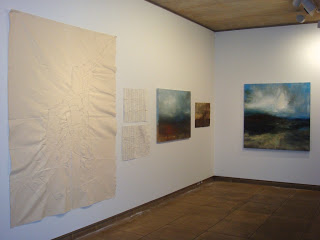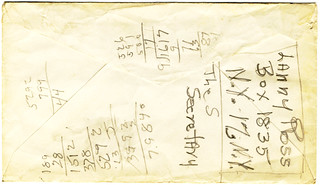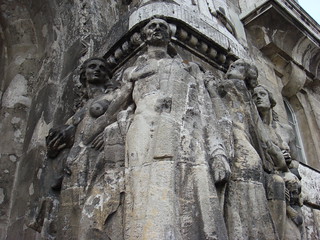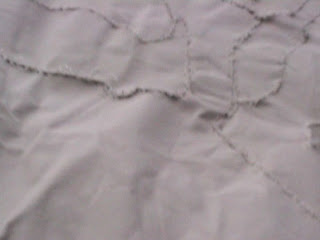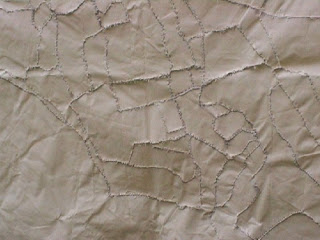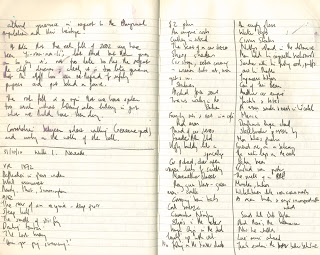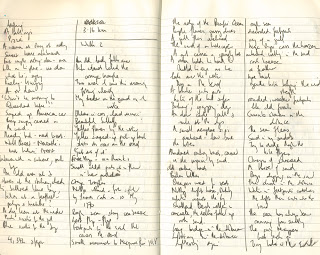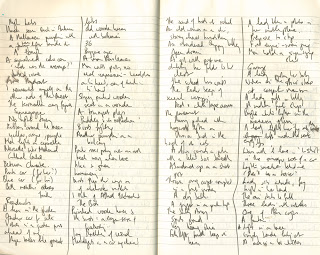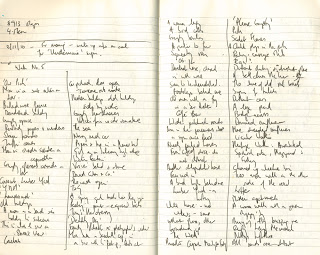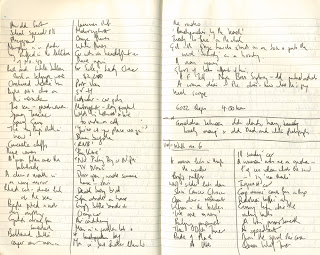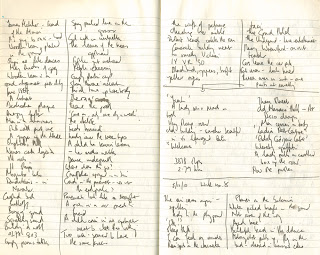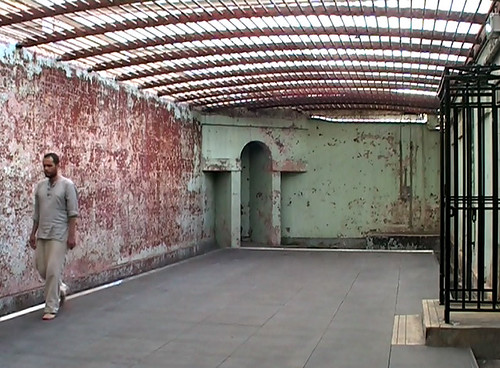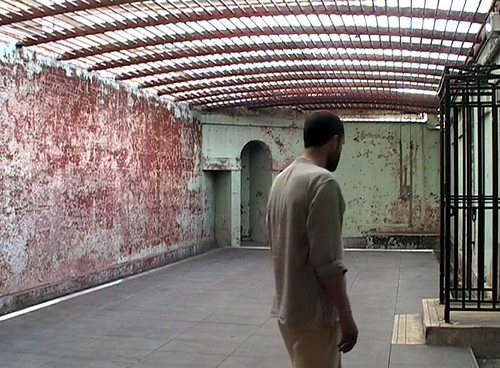Some photos from Kaleidoscope; the exhibition I, along with my fiancee Addy Gardner, are currently staging at The North Wall Gallery, South Parade, Summertown, Oxford. The exhibition runs until 3rd November. See website for more details.
Maps: A Unifying Aesthetic
For some time I have been searching for what one might describe as a unifying aesthetic; a process for creating a work with an aesthetic appearance which serves not only to appeal visually, but which also conveys meaning.
There are numerous things which appeal to me aesthetically such as (in no particular order); palimpsests (sheets of paper or parchment where words are erased but never completely and over which new text is added, to then be erased and so on), notebooks (such as those belonging to Walter Benjamin), patched up papers, maps (like old trench maps), lines (like scratches on surfaces or pencil marks), poster sites (where the posters have been pasted one on top of the other and ripped), drips and splashes of paint, blurs, text in paintings (particularly pencil), stains, things faded, fragments, old writing and so on.
Some examples of what I mean:
My work is about time, life, death and memory. It is concerned with empathy and in particular empathy as an ever expanding dialogue between bodily experience and knowledge. But what form should my work take to encompass all these things?
It was whilst in Edinburgh with my fiancee, that I began to find that form. It started with an exhibition of work by Tony Swain, who uses text as a source for his work, not so much in terms of the words, but in the substance on which they’re printed; in his case, newspapers. What I liked about his work in particular was its organic quality, the fact that it could be expanded, new sheets added to create large landscapes such as that below.
Then whilst visiting St. Giles church in Edinburgh, I saw the National Covenant on display; a 17th century document which I found – aesthetically speaking – quite beautiful. Comprising a large sheet of parchment, one could see the folds and also patches of parchment which had been added to the main sheet. The different sizes of writing also appealed, just as they do in notebooks – such as those of Walter Benjamin.
A version of the covenant can be seen below:
When I bought a World War I trench map a few months ago, I did some observation work on it and wrote the following regarding the way it had been folded:
“It doesn’t resist being folded again. First vertically and then horizontally.
I unfold it and instinctively flatten it down. The folds in places rise up. The fold which runs vertically through the red lines does especially. This part of the map won’t remain flat unless I press it down with my hand. As I do, my head instinctively lifts a little and my eyes move along the lines of red to rest around the village of Thiepval.
These actions would no doubt have been repeated in the past when the map was perhaps more pristine – when the folds were sharper and the map lay flat.
The map, when I lift it up, seems to want to fold into a particular shape. It doesn’t want to be put away, but rather be folded so that two columns remain in view. The folds which delineate this part are a darker brown than all the others. In this section of the map is a concentration of red lines and blue lines.
The way it folds suggests that this was what was most important. When I pick up the map to fold it completely, it folds so that the ‘front’ and ‘reverse’ are tucked away. The front now is one of the segments or ‘squares’ containing French words (Sondage) and their English equivalents (Boring – as in cut).
The past movements associated with this map are therefore recorded in its folds. It resists being folded any other way.”
The last line is particularly important. Empathy is an emotion felt with the body, requiring an embodied imagination to articulate the dialogue between bodily experience and knowledge. The folds in the map enable me to record the sense of past movement in a two dimensional space. And creating a kind of map allows me to explore the past in terms of its being a place. When I was a child, history was very much a way into a place, a world of woods and forests untouched by the mechanised age. Text was therefore a precursor to what would eventually emerge as an image and the two would often combine on the maps I created.
Creating some kind of map is what I want to do, but a map which evolves, that’s organic, which changes continuously.
The Trial of Stephen Hedges 1828 in Morse Code
Transcript
Berkshire Easter Sessions Newbury 1815. H. Stockwell, J. Harper (not in custody,) and S. Hedges of Abingdon, were indicted for stealing 154 lbs of lead, at Radley, the property of Benjamin Kent and Charles Jones, of Oxford, for receiving the lead, knowing it to be stolen. Stockwell and Hedges pleaded Guilty, but Jones pleaded “Not Guilty”. Jones was then put on trial for receiving the lead with a felonious knowledge etc. from the two prisoners who pleaded guilty. Mr. Shepherd said, he appeared on behalf of Mr. Kent, the prosecutor of Jones, under a new statute, (sec. 447, Geo. IV. C.29) which made the offence a felony. By the 54th sec. of the same statute the receiving of property feloniously stolen would constitute a felony. The circumstances of the case were sufficiently strong to satisfy the Jury that the lead was stolen. Mr. Kent examined I live at RadleyHouse about 100 yards from the office is a larder the roof is covered with lead. In January last a considerable quantity of it was stolen. Crossexamined by Mr. Talfourd I am tenant of the house. Sir James Bowyer is the proprietor. I am yearly tenant. James Smith examined I am servant to Mr. Kent the hips of the larder were covered with lead. The lead was stolen in January last I saw it gone on the 29th January. There was a ladder found near to the ditch. There were three hips cleared of lead. Richard Burgess examined I live at Abingdon, I am a sawyer on the 28th of January I went to Oxford, and on the road, having some bones in my cart to sell, I met the three men, Stockwell, Hedges and Harper. Hedges asked me if I were going to Oxford? And would I carry a parcel? I carried a parcel for them. Harper went back for something, for a bag the other two went on with me. Near Sir G. Bowyer’s Lodge I was desired to stop. I at first objected, but I did stop about five minutes.
Harper soon afterwards came up with a bag they went into a plantation, near where Mr. Kent lives they were not five minutes away when they brought a bag, which appeared to be very heavy. I never saw what was in the bag. Stockwell carried a piece of lead on his shoulder. This was afterwards put in the bag by Hedges and Stockwell. Shortly after Jones met the prisoners, and they had some conversation together. I went on to Oxford, to Mr. Round’s wharf and near the gates I put the parcel of lead down, and delivered the bones to be weighed. Stockwell and Jones came up in about half an hour, and put the bag with the lead into the cart again. I said, where are you to take this? And Jones said “Come on back again follow me.” I followed him up the Cityroad and near the Castle met Hedges and Harper. They turned back with us through Butcherrow when Jones called out, “Hold off there here it is,” meaning the place where it was to be taken to. The bag was taken out of the cart by Jones and Stockwell, and carried up a passage by Stockwell. They soon after came back, but I did not notice they had the bag. Jones said, “What are you going to give the man for bringing it?” When Stockwell said give him sixpence, and Jones did so. Crossexamined by Mr. Talfourd I am a sawyer I don’t collect bones. I don’t deal in lead. I did not know what was in the bag I had no suspicion whatever. I was carrying the bones for Mr. Owen of Abingdon. Mr. John King examined I am a glazier, in Oxford. I know Jones on the 28th January I saw him at my house. He came to say he had some lead to sell. I told him I wanted lead and asked him what price he wanted? He said 16s a hundred. I said lead was low in price, and if it was good for any thing I would buy it. He brought me the lead in about half an hour he said he had a hundred and a half.
Three young men came with him, but I should not know them again. I paid Jones for the lead he received 20s. 6d. It was in three pieces, I believe. Some pieces were afterwards cut up by my shopman. It corresponded with the hips from which it had been taken. James Smith produced the lead. The lead was given to me by Mr. Walker, the gaoler. I marked the lead before the Magistrates. Crossexamined. The price I gave was a fair price. I had before dealt with Jones, and have known him three or four years. I had never heard any thing against his character. Mr. D. Godfrey examined. I was present at the examination of Jones what he said I took down myself. This is the signature of Mr. Bowles, the Magistrate. The prisoner declined signing his statement. [It stated that the three prisoners asked him where there was a fence for lead. And then corroborated a good deal of the testimony as adduced by the prosecution.] Mr. Talfourd submitted there was no evidence of receiving to go to the Jury no actual receiving into possession. Mr Shepherd. That will be for the Jury to decide upon. Mr. Talfourd. And that is precisely what I mean to say. Chairman. He receives the lead, and makes a bargain for the sale of it. And if that is not receiving, I am at a loss to know what receiving is. Rev. Mr. Sawbridge. And he pays the carriage of the lead. E. Gardener Esq. Yes, and he helped to carry it up the passage. The prisoner in his defence said, I asked Stockwell how he came by the lead, when he replied Hedges is captain, and got it where he had been at work.
I said I would go to Mr. King, for there I could get a fair price. Stockwell wanted 14s or more for the hundred weight, and I told them all to go to Mr. King if they pleased. At last it was agreed I was to have all above 13s. for the first hundred, and all above 14s for the remainder. I have been left friendless for nine years, and have got the best living I could buying sheepskins, rabbitskins, or anything else, for I was not nice. When the young gentleman are at the University, I make pastry, and carry it about from house to house. I have one friend in court, a Mr. Dyer. Isaac Dyer called. I am brotherinlaw to the prisoner I am a confectioner at Abingdon I have known Jones for twelve years nearly, and always understood him to be an upright and bright character. He has been a youth of a thousand honestyry, and for getting through difficulties by industrysy. The Chairman summed up the case to the Jury. If the Jury were of opinion, that he did not know the lead was stolen that he had not a guilty knowledge, they must acquit him. Verdict Not Guilty. The Chairman cautioned Jones, previous to his discharge, to avoid purchasing lead and other articles, in future he had had a very narrow escape. Jones. I trust in God I shall it shall be a thorough caution. Hedges and Stockwell were ordered to stand at the bar, and were told their offence was not of a trifling nature, for, by a very old statute, it was severely punished and by the present statute the course may pass sentence of transportation. Under all the circumstances the sentence of the court was, that they be transported for seven years. In quitting the bar, Stockwell struck Hedges familiarly on the back, and laughed.
Transcript in Morse Code
-… . .-. -.- … …. .. .-. . / . .- … – . .-. / … . … … .. — -. … / -. . .– -… ..- .-. -.– / .—- —.. .—- ….. .-.-.- / …. .-.-.- / … – — -.-. -.- .– . .-.. .-.. –..– / .— .-.-.- / …. .- .-. .–. . .-. / -.–.- -. — – / .. -. / -.-. ..- … – — -.. -.– –..– -.–.- / .- -. -.. / … .-.-.- / …. . -.. –. . … / — ..-. / .- -… .. -. –. -.. — -. –..– / .– . .-. . / .. -. -.. .. -.-. – . -.. / ..-. — .-. / … – . .- .-.. .. -. –. / .—- ….. ….- / .-.. -… … / — ..-. / .-.. . .- -.. –..– / .- – / .-. .- -.. .-.. . -.– –..– / – …. . / .–. .-. — .–. . .-. – -.– / — ..-. / -… . -. .— .- — .. -. / -.- . -. – / .- -. -.. / -.-. …. .- .-. .-.. . … / .— — -. . … –..– / — ..-. / — -..- ..-. — .-. -.. –..– / ..-. — .-. / .-. . -.-. . .. …- .. -. –. / – …. . / .-.. . .- -.. –..– / -.- -. — .– .. -. –. / .. – / – — / -… . / … – — .-.. . -. .-.-.- / … – — -.-. -.- .– . .-.. .-.. / .- -. -.. / …. . -.. –. . … / .–. .-.. . .- -.. . -.. / –. ..- .. .-.. – -.– –..– / -… ..- – / .— — -. . … / .–. .-.. . .- -.. . -.. / .-..-. -. — – / –. ..- .. .-.. – -.– .-..-. .-.-.- / .— — -. . … / .– .- … / – …. . -. / .–. ..- – / — -. / – .-. .. .- .-.. / ..-. — .-. / .-. . -.-. . .. …- .. -. –. / – …. . / .-.. . .- -.. / .– .. – …. / .- / ..-. . .-.. — -. .. — ..- … / -.- -. — .– .-.. . -.. –. . / . – -.-. .-.-.- / ..-. .-. — — / – …. . / – .– — / .–. .-. .. … — -. . .-. … / .– …. — / .–. .-.. . .- -.. . -.. / –. ..- .. .-.. – -.– .-.-.- / — .-. .-.-.- / … …. . .–. …. . .-. -.. / … .- .. -.. –..– / …. . / .- .–. .–. . .- .-. . -.. / — -. / -… . …. .- .-.. ..-. / — ..-. / — .-. .-.-.- / -.- . -. – –..– / – …. . / .–. .-. — … . -.-. ..- – — .-. / — ..-. / .— — -. . … –..– / ..- -. -.. . .-. / .- / -. . .– / … – .- – ..- – . –..– / -.–.- … . -.-. .-.-.- / ….- ….- –… –..– / –. . — .-.-.- / .. …- .-.-.- / -.-. .-.-.- ..— —-. -.–.- / .– …. .. -.-. …. / — .- -.. . / – …. . / — ..-. ..-. . -. -.-. . / .- / ..-. . .-.. — -. -.– .-.-.- / -… -.– / – …. . / ….. ….- – …. / … . -.-. .-.-.- / — ..-. / – …. . / … .- — . / … – .- – ..- – . / – …. . / .-. . -.-. . .. …- .. -. –. / — ..-. / .–. .-. — .–. . .-. – -.– / ..-. . .-.. — -. .. — ..- … .-.. -.– / … – — .-.. . -. / .– — ..- .-.. -.. / -.-. — -. … – .. – ..- – . / .- / ..-. . .-.. — -. -.– .-.-.- / – …. . / -.-. .. .-. -.-. ..- — … – .- -. -.-. . … / — ..-. / – …. . / -.-. .- … . / .– . .-. . / … ..- ..-. ..-. .. -.-. .. . -. – .-.. -.– / … – .-. — -. –. / – — / … .- – .. … ..-. -.– / – …. . / .— ..- .-. -.– / – …. .- – / – …. . / .-.. . .- -.. / .– .- … / … – — .-.. . -. .-.-.- / — .-. .-.-.- / -.- . -. – / . -..- .- — .. -. . -.. / .. / .-.. .. …- . / .- – / .-. .- -.. .-.. . -.– …. — ..- … . / .- -… — ..- – / .—- —– —– / -.– .- .-. -.. … / ..-. .-. — — / – …. . / — ..-. ..-. .. -.-. . / .. … / .- / .-.. .- .-. -.. . .-. / – …. . / .-. — — ..-. / .. … / -.-. — …- . .-. . -.. / .– .. – …. / .-.. . .- -.. .-.-.- / .. -. / .— .- -. ..- .- .-. -.– / .-.. .- … – / .- / -.-. — -. … .. -.. . .-. .- -… .-.. . / –.- ..- .- -. – .. – -.– / — ..-. / .. – / .– .- … / … – — .-.. . -. .-.-.- / -.-. .-. — … … . -..- .- — .. -. . -.. / -… -.– / — .-. .-.-.- / – .- .-.. ..-. — ..- .-. -.. / .. / .- — / – . -. .- -. – / — ..-. / – …. . / …. — ..- … . .-.-.- / … .. .-. / .— .- — . … / -… — .– -.– . .-. / .. … / – …. . / .–. .-. — .–. .-. .. . – — .-. .-.-.- / .. / .- — / -.– . .- .-. .-.. -.– / – . -. .- -. – .-.-.- / .— .- — . … / … — .. – …. / . -..- .- — .. -. . -.. / .. / .- — / … . .-. …- .- -. – / – — / — .-. .-.-.- / -.- . -. – / – …. . / …. .. .–. … / — ..-. / – …. . / .-.. .- .-. -.. . .-. / .– . .-. . / -.-. — …- . .-. . -.. / .– .. – …. / .-.. . .- -.. .-.-.- / – …. . / .-.. . .- -.. / .– .- … / … – — .-.. . -. / .. -. / .— .- -. ..- .- .-. -.– / .-.. .- … – / .. / … .- .– / .. – / –. — -. . / — -. / – …. . / ..— —-. – …. / .— .- -. ..- .- .-. -.– .-.-.- / – …. . .-. . / .– .- … / .- / .-.. .- -.. -.. . .-. / ..-. — ..- -. -.. / -. . .- .-. / – — / – …. . / -.. .. – -.-. …. .-.-.- / – …. . .-. . / .– . .-. . / – …. .-. . . / …. .. .–. … / -.-. .-.. . .- .-. . -.. / — ..-. / .-.. . .- -.. .-.-.- / .-. .. -.-. …. .- .-. -.. / -… ..- .-. –. . … … / . -..- .- — .. -. . -.. / .. / .-.. .. …- . / .- – / .- -… .. -. –. -.. — -. –..– / .. / .- — / .- / … .- .– -.– . .-. / — -. / – …. . / ..— —.. – …. / — ..-. / .— .- -. ..- .- .-. -.– / .. / .– . -. – / – — / — -..- ..-. — .-. -.. –..– / .- -. -.. / — -. / – …. . / .-. — .- -.. –..– / …. .- …- .. -. –. / … — — . / -… — -. . … / .. -. / — -.– / -.-. .- .-. – / – — / … . .-.. .-.. –..– / .. / — . – / – …. . / – …. .-. . . / — . -. –..– / … – — -.-. -.- .– . .-.. .-.. –..– / …. . -.. –. . … / .- -. -.. / …. .- .-. .–. . .-. .-.-.- / …. . -.. –. . … / .- … -.- . -.. / — . / .. ..-. / .. / .– . .-. . / –. — .. -. –. / – — / — -..- ..-. — .-. -.. ..–.. / .- -. -.. / .– — ..- .-.. -.. / .. / -.-. .- .-. .-. -.– / .- / .–. .- .-. -.-. . .-.. ..–.. / .. / -.-. .- .-. .-. .. . -.. / .- / .–. .- .-. -.-. . .-.. / ..-. — .-. / – …. . — .-.-.- / …. .- .-. .–. . .-. / .– . -. – / -… .- -.-. -.- / ..-. — .-. / … — — . – …. .. -. –. –..– / ..-. — .-. / .- / -… .- –. / – …. . / — – …. . .-. / – .– — / .– . -. – / — -. / .– .. – …. / — . .-.-.- / -. . .- .-. / … .. .-. / –. .-.-.- / -… — .– -.– . .-. .—-. … / .-.. — -.. –. . / .. / .– .- … / -.. . … .. .-. . -.. / – — / … – — .–. .-.-.- / .. / .- – / ..-. .. .-. … – / — -… .— . -.-. – . -.. –..– / -… ..- – / .. / -.. .. -.. / … – — .–. / .- -… — ..- – / ..-. .. …- . / — .. -. ..- – . … .-.-.- / …. .- .-. .–. . .-. / … — — -. / .- ..-. – . .-. .– .- .-. -.. … / -.-. .- — . / ..- .–. / .– .. – …. / .- / -… .- –. / – …. . -.– / .– . -. – / .. -. – — / .- / .–. .-.. .- -. – .- – .. — -. –..– / -. . .- .-. / .– …. . .-. . / — .-. .-.-.- / -.- . -. – / .-.. .. …- . … / – …. . -.– / .– . .-. . / -. — – / ..-. .. …- . / — .. -. ..- – . … / .- .– .- -.– / .– …. . -. / – …. . -.– / -… .-. — ..- –. …. – / .- / -… .- –. –..– / .– …. .. -.-. …. / .- .–. .–. . .- .-. . -.. / – — / -… . / …- . .-. -.– / …. . .- …- -.– .-.-.- / .. / -. . …- . .-. / … .- .– / .– …. .- – / .– .- … / .. -. / – …. . / -… .- –. .-.-.- / … – — -.-. -.- .– . .-.. .-.. / -.-. .- .-. .-. .. . -.. / .- / .–. .. . -.-. . / — ..-. / .-.. . .- -.. / — -. / …. .. … / … …. — ..- .-.. -.. . .-. .-.-.- / – …. .. … / .– .- … / .- ..-. – . .-. .– .- .-. -.. … / .–. ..- – / .. -. / – …. . / -… .- –. / -… -.– / …. . -.. –. . … / .- -. -.. / … – — -.-. -.- .– . .-.. .-.. .-.-.- / … …. — .-. – .-.. -.– / .- ..-. – . .-. / .— — -. . … / — . – / – …. . / .–. .-. .. … — -. . .-. … –..– / .- -. -.. / – …. . -.– / …. .- -.. / … — — . / -.-. — -. …- . .-. … .- – .. — -. / – — –. . – …. . .-. .-.-.- / .. / .– . -. – / — -. / – — / — -..- ..-. — .-. -.. –..– / – — / — .-. .-.-.- / .-. — ..- -. -.. .—-. … / .– …. .- .-. ..-. / .- -. -.. / -. . .- .-. / – …. . / –. .- – . … / .. / .–. ..- – / – …. . / .–. .- .-. -.-. . .-.. / — ..-. / .-.. . .- -.. / -.. — .– -. –..– / .- -. -.. / -.. . .-.. .. …- . .-. . -.. / – …. . / -… — -. . … / – — / -… . / .– . .. –. …. . -.. .-.-.- / … – — -.-. -.- .– . .-.. .-.. / .- -. -.. / .— — -. . … / -.-. .- — . / ..- .–. / .. -. / .- -… — ..- – / …. .- .-.. ..-. / .- -. / …. — ..- .-. –..– / .- -. -.. / .–. ..- – / – …. . / -… .- –. / .– .. – …. / – …. . / .-.. . .- -.. / .. -. – — / – …. . / -.-. .- .-. – / .- –. .- .. -. .-.-.- / .. / … .- .. -.. –..– / .– …. . .-. . / .- .-. . / -.– — ..- / – — / – .- -.- . / – …. .. … ..–.. / .- -. -.. / .— — -. . … / … .- .. -.. / .-..-. -.-. — — . / — -. / -… .- -.-. -.- / .- –. .- .. -. / ..-. — .-.. .-.. — .– / — . .-.-.- .-..-. / .. / ..-. — .-.. .-.. — .– . -.. / …. .. — / ..- .–. / – …. . / -.-. .. – -.– .-. — .- -.. / .- -. -.. / -. . .- .-. / – …. . / -.-. .- … – .-.. . / — . – / …. . -.. –. . … / .- -. -.. / …. .- .-. .–. . .-. .-.-.- / – …. . -.– / – ..- .-. -. . -.. / -… .- -.-. -.- / .– .. – …. / ..- … / – …. .-. — ..- –. …. / -… ..- – -.-. …. . .-. .-. — .– / .– …. . -. / .— — -. . … / -.-. .- .-.. .-.. . -.. / — ..- – –..– / .-..-. …. — .-.. -.. / — ..-. ..-. / – …. . .-. . / …. . .-. . / .. – / .. … –..– .-..-. / — . .- -. .. -. –. / – …. . / .–. .-.. .- -.-. . / .– …. . .-. . / .. – / .– .- … / – — / -… . / – .- -.- . -. / – — .-.-.- / – …. . / -… .- –. / .– .- … / – .- -.- . -. / — ..- – / — ..-. / – …. . / -.-. .- .-. – / -… -.– / .— — -. . … / .- -. -.. / … – — -.-. -.- .– . .-.. .-.. –..– / .- -. -.. / -.-. .- .-. .-. .. . -.. / ..- .–. / .- / .–. .- … … .- –. . / -… -.– / … – — -.-. -.- .– . .-.. .-.. .-.-.- / – …. . -.– / … — — -. / .- ..-. – . .-. / -.-. .- — . / -… .- -.-. -.- –..– / -… ..- – / .. / -.. .. -.. / -. — – / -. — – .. -.-. . / – …. . -.– / …. .- -.. / – …. . / -… .- –. .-.-.- / .— — -. . … / … .- .. -.. –..– / .-..-. .– …. .- – / .- .-. . / -.– — ..- / –. — .. -. –. / – — / –. .. …- . / – …. . / — .- -. / ..-. — .-. / -… .-. .. -. –. .. -. –. / .. – ..–.. .-..-. / .– …. . -. / … – — -.-. -.- .– . .-.. .-.. / … .- .. -.. / –. .. …- . / …. .. — / … .. -..- .–. . -. -.-. . –..– / .- -. -.. / .— — -. . … / -.. .. -.. / … — .-.-.- / -.-. .-. — … … . -..- .- — .. -. . -.. / -… -.– / — .-. .-.-.- / – .- .-.. ..-. — ..- .-. -.. / .. / .- — / .- / … .- .– -.– . .-. / .. / -.. — -. .—-. – / -.-. — .-.. .-.. . -.-. – / -… — -. . … .-.-.- / .. / -.. — -. .—-. – / -.. . .- .-.. / .. -. / .-.. . .- -.. .-.-.- / .. / -.. .. -.. / -. — – / -.- -. — .– / .– …. .- – / .– .- … / .. -. / – …. . / -… .- –. / .. / …. .- -.. / -. — / … ..- … .–. .. -.-. .. — -. / .– …. .- – . …- . .-. .-.-.- / .. / .– .- … / -.-. .- .-. .-. -.– .. -. –. / – …. . / -… — -. . … / ..-. — .-. / — .-. .-.-.- / — .– . -. / — ..-. / .- -… .. -. –. -.. — -. .-.-.- / — .-. .-.-.- / .— — …. -. / -.- .. -. –. / . -..- .- — .. -. . -.. / .. / .- — / .- / –. .-.. .- –.. .. . .-. –..– / .. -. / — -..- ..-. — .-. -.. .-.-.- / .. / -.- -. — .– / .— — -. . … / — -. / – …. . / ..— —.. – …. / .— .- -. ..- .- .-. -.– / .. / … .- .– / …. .. — / .- – / — -.– / …. — ..- … . .-.-.- / …. . / -.-. .- — . / – — / … .- -.– / …. . / …. .- -.. / … — — . / .-.. . .- -.. / – — / … . .-.. .-.. .-.-.- / .. / – — .-.. -.. / …. .. — / .. / .– .- -. – . -.. / .-.. . .- -.. / .- -. -.. / .- … -.- . -.. / …. .. — / .– …. .- – / .–. .-. .. -.-. . / …. . / .– .- -. – . -.. ..–.. / …. . / … .- .. -.. / .—- -…. … / .- / …. ..- -. -.. .-. . -.. .-.-.- / .. / … .- .. -.. / .-.. . .- -.. / .– .- … / .-.. — .– / .. -. / .–. .-. .. -.-. . –..– / .- -. -.. / .. ..-. / .. – / .– .- … / –. — — -.. / ..-. — .-. / .- -. -.– / – …. .. -. –. / .. / .– — ..- .-.. -.. / -… ..- -.– / .. – .-.-.- / …. . / -… .-. — ..- –. …. – / — . / – …. . / .-.. . .- -.. / .. -. / .- -… — ..- – / …. .- .-.. ..-. / .- -. / …. — ..- .-. / …. . / … .- .. -.. / …. . / …. .- -.. / .- / …. ..- -. -.. .-. . -.. / .- -. -.. / .- / …. .- .-.. ..-. .-.-.- / – …. .-. . . / -.– — ..- -. –. / — . -. / -.-. .- — . / .– .. – …. / …. .. — –..– / -… ..- – / .. / … …. — ..- .-.. -.. / -. — – / -.- -. — .– / – …. . — / .- –. .- .. -. .-.-.- / .. / .–. .- .. -.. / .— — -. . … / ..-. — .-. / – …. . / .-.. . .- -.. / …. . / .-. . -.-. . .. …- . -.. / ..— —– … .-.-.- / -…. -.. .-.-.- / .. – / .– .- … / .. -. / – …. .-. . . / .–. .. . -.-. . … –..– / .. / -… . .-.. .. . …- . .-.-.- / … — — . / .–. .. . -.-. . … / .– . .-. . / .- ..-. – . .-. .– .- .-. -.. … / -.-. ..- – / ..- .–. / -… -.– / — -.– / … …. — .–. — .- -. .-.-.- / .. – / -.-. — .-. .-. . … .–. — -. -.. . -.. / .– .. – …. / – …. . / …. .. .–. … / ..-. .-. — — / .– …. .. -.-. …. / .. – / …. .- -.. / -… . . -. / – .- -.- . -. .-.-.- / .— .- — . … / … — .. – …. / .–. .-. — -.. ..- -.-. . -.. / – …. . / .-.. . .- -.. .-.-.- / – …. . / .-.. . .- -.. / .– .- … / –. .. …- . -. / – — / — . / -… -.– / — .-. .-.-.- / .– .- .-.. -.- . .-. –..– / – …. . / –. .- — .-.. . .-. .-.-.- / .. / — .- .-. -.- . -.. / – …. . / .-.. . .- -.. / -… . ..-. — .-. . / – …. . / — .- –. .. … – .-. .- – . … .-.-.- / -.-. .-. — … … . -..- .- — .. -. . -.. .-.-.- / – …. . / .–. .-. .. -.-. . / .. / –. .- …- . / .– .- … / .- / ..-. .- .. .-. / .–. .-. .. -.-. . .-.-.- / .. / …. .- -.. / -… . ..-. — .-. . / -.. . .- .-.. – / .– .. – …. / .— — -. . … –..– / .- -. -.. / …. .- …- . / -.- -. — .– -. / …. .. — / – …. .-. . . / — .-. / ..-. — ..- .-. / -.– . .- .-. … .-.-.- / .. / …. .- -.. / -. . …- . .-. / …. . .- .-. -.. / .- -. -.– / – …. .. -. –. / .- –. .- .. -. … – / …. .. … / -.-. …. .- .-. .- -.-. – . .-. .-.-.- / — .-. .-.-.- / -.. .-.-.- / –. — -.. ..-. .-. . -.– / . -..- .- — .. -. . -.. .-.-.- / .. / .– .- … / .–. .-. . … . -. – / .- – / – …. . / . -..- .- — .. -. .- – .. — -. / — ..-. / .— — -. . … / .– …. .- – / …. . / … .- .. -.. / .. / – — — -.- / -.. — .– -. / — -.– … . .-.. ..-. .-.-.- / – …. .. … / .. … / – …. . / … .. –. -. .- – ..- .-. . / — ..-. / — .-. .-.-.- / -… — .– .-.. . … –..– / – …. . / — .- –. .. … – .-. .- – . .-.-.- / – …. . / .–. .-. .. … — -. . .-. / -.. . -.-. .-.. .. -. . -.. / … .. –. -. .. -. –. / …. .. … / … – .- – . — . -. – .-.-.- / ? .. – / … – .- – . -.. / – …. .- – / – …. . / – …. .-. . . / .–. .-. .. … — -. . .-. … / .- … -.- . -.. / …. .. — / .– …. . .-. . / – …. . .-. . / .– .- … / .- / ..-. . -. -.-. . / ..-. — .-. / .-.. . .- -.. .-.-.- / .- -. -.. / – …. . -. / -.-. — .-. .-. — -… — .-. .- – . -.. / .- / –. — — -.. / -.. . .- .-.. / — ..-. / – …. . / – . … – .. — — -. -.– / .- … / .- -.. -.. ..- -.-. . -.. / -… -.– / – …. . / .–. .-. — … . -.-. ..- – .. — -. .-.-.- ? / — .-. .-.-.- / – .- .-.. ..-. — ..- .-. -.. / … ..- -… — .. – – . -.. / – …. . .-. . / .– .- … / -. — / . …- .. -.. . -. -.-. . / — ..-. / .-. . -.-. . .. …- .. -. –. / – — / –. — / – — / – …. . / .— ..- .-. -.– / -. — / .- -.-. – ..- .- .-.. / .-. . -.-. . .. …- .. -. –. / .. -. – — / .–. — … … . … … .. — -. .-.-.- / — .-. / … …. . .–. …. . .-. -.. .-.-.- / – …. .- – / .– .. .-.. .-.. / -… . / ..-. — .-. / – …. . / .— ..- .-. -.– / – — / -.. . -.-. .. -.. . / ..- .–. — -. .-.-.- / — .-. .-.-.- / – .- .-.. ..-. — ..- .-. -.. .-.-.- / .- -. -.. / – …. .- – / .. … / .–. .-. . -.-. .. … . .-.. -.– / .– …. .- – / .. / — . .- -. / – — / … .- -.– .-.-.- / -.-. …. .- .. .-. — .- -. .-.-.- / …. . / .-. . -.-. . .. …- . … / – …. . / .-.. . .- -.. –..– / .- -. -.. / — .- -.- . … / .- / -… .- .-. –. .- .. -. / ..-. — .-. / – …. . / … .- .-.. . / — ..-. / .. – .-.-.- / .- -. -.. / .. ..-. / – …. .- – / .. … / -. — – / .-. . -.-. . .. …- .. -. –. –..– / .. / .- — / .- – / .- / .-.. — … … / – — / -.- -. — .– / .– …. .- – / .-. . -.-. . .. …- .. -. –. / .. … .-.-.- / .-. . …- .-.-.- / — .-. .-.-.- / … .- .– -… .-. .. -.. –. . .-.-.- / .- -. -.. / …. . / .–. .- -.– … / – …. . / -.-. .- .-. .-. .. .- –. . / — ..-. / – …. . / .-.. . .- -.. .-.-.- / . .-.-.- / –. .- .-. -.. . -. . .-. / . … –.- .-.-.- / -.– . … –..– / .- -. -.. / …. . / …. . .-.. .–. . -.. / – — / -.-. .- .-. .-. -.– / .. – / ..- .–. / – …. . / .–. .- … … .- –. . .-.-.- / – …. . / .–. .-. .. … — -. . .-. / .. -. / …. .. … / -.. . ..-. . -. -.-. . / … .- .. -.. –..– / .. / .- … -.- . -.. / … – — -.-. -.- .– . .-.. .-.. / …. — .– / …. . / -.-. .- — . / -… -.– / – …. . / .-.. . .- -.. –..– / .– …. . -. / …. . / .-. . .–. .-.. .. . -.. / …. . -.. –. . … / .. … / -.-. .- .–. – .- .. -. –..– / .- -. -.. / –. — – / .. – / .– …. . .-. . / …. . / …. .- -.. / -… . . -. / .- – / .– — .-. -.- .-.-.- / .. / … .- .. -.. / .. / .– — ..- .-.. -.. / –. — / – — / — .-. .-.-.- / -.- .. -. –. –..– / ..-. — .-. / – …. . .-. . / .. / -.-. — ..- .-.. -.. / –. . – / .- / ..-. .- .. .-. / .–. .-. .. -.-. . .-.-.- / … – — -.-. -.- .– . .-.. .-.. / .– .- -. – . -.. / .—- ….- … / — .-. / — — .-. . / ..-. — .-. / – …. . / …. ..- -. -.. .-. . -.. / .– . .. –. …. – –..– / .- -. -.. / .. / – — .-.. -.. / – …. . — / .- .-.. .-.. / – — / –. — / – — / — .-. .-.-.- / -.- .. -. –. / .. ..-. / – …. . -.– / .–. .-.. . .- … . -.. .-.-.- / .- – / .-.. .- … – / .. – / .– .- … / .- –. .-. . . -.. / .. / .– .- … / – — / …. .- …- . / .- .-.. .-.. / .- -… — …- . / .—- …– … .-.-.- / ..-. — .-. / – …. . / ..-. .. .-. … – / …. ..- -. -.. .-. . -.. –..– / .- -. -.. / .- .-.. .-.. / .- -… — …- . / .—- ….- … / ..-. — .-. / – …. . / .-. . — .- .. -. -.. . .-. .-.-.- / .. / …. .- …- . / -… . . -. / .-.. . ..-. – / ..-. .-. .. . -. -.. .-.. . … … / ..-. — .-. / -. .. -. . / -.– . .- .-. … –..– / .- -. -.. / …. .- …- . / –. — – / – …. . / -… . … – / .-.. .. …- .. -. –. / .. / -.-. — ..- .-.. -.. / -… ..- -.– .. -. –. / … …. . . .–. … -.- .. -. … –..– / .-. .- -… -… .. – … -.- .. -. … –..– / — .-. / .- -. -.– – …. .. -. –. / . .-.. … . –..– / ..-. — .-. / .. / .– .- … / -. — – / -. .. -.-. . .-.-.- / .– …. . -. / – …. . / -.– — ..- -. –. / –. . -. – .-.. . — .- -. / .- .-. . / .- – / – …. . / ..- -. .. …- . .-. … .. – -.– –..– / .. / — .- -.- . / .–. .- … – .-. -.– –..– / .- -. -.. / -.-. .- .-. .-. -.– / .. – / .- -… — ..- – / ..-. .-. — — / …. — ..- … . / – — / …. — ..- … . .-.-.- / .. / …. .- …- . / — -. . / ..-. .-. .. . -. -.. / .. -. / -.-. — ..- .-. – –..– / .- / — .-. .-.-.- / -.. -.– . .-. .-.-.- / .. … .- .- -.-. / -.. -.– . .-. / -.-. .- .-.. .-.. . -.. .-.-.- / .. / .- — / -… .-. — – …. . .-. .. -. .-.. .- .– / – — / – …. . / .–. .-. .. … — -. . .-. / .. / .- — / .- / -.-. — -. ..-. . -.-. – .. — -. . .-. / .- – / .- -… .. -. –. -.. — -. / .. / …. .- …- . / -.- -. — .– -. / .— — -. . … / ..-. — .-. / – .– . .-.. …- . / -.– . .- .-. … / -. . .- .-. .-.. -.– –..– / .- -. -.. / .- .-.. .– .- -.– … / ..- -. -.. . .-. … – — — -.. / …. .. — / – — / -… . / .- -. / ..- .–. .-. .. –. …. – / .- -. -.. / -… .-. .. –. …. – / -.-. …. .- .-. .- -.-. – . .-. .-.-.- / …. . / …. .- … / -… . . -. / .- / -.– — ..- – …. / — ..-. / .- / – …. — ..- … .- -. -.. / …. — -. . … – -.– .-. -.– –..– / .- -. -.. / ..-. — .-. / –. . – – .. -. –. / – …. .-. — ..- –. …. / -.. .. ..-. ..-. .. -.-. ..- .-.. – .. . … / -… -.– / .. -. -.. ..- … – .-. -.– … -.– .-.-.- / – …. . / -.-. …. .- .. .-. — .- -. / … ..- — — . -.. / ..- .–. / – …. . / -.-. .- … . / – — / – …. . / .— ..- .-. -.– .-.-.- / .. ..-. / – …. . / .— ..- .-. -.– / .– . .-. . / — ..-. / — .–. .. -. .. — -. –..– / – …. .- – / …. . / -.. .. -.. / -. — – / -.- -. — .– / – …. . / .-.. . .- -.. / .– .- … / … – — .-.. . -. / – …. .- – / …. . / …. .- -.. / -. — – / .- / –. ..- .. .-.. – -.– / -.- -. — .– .-.. . -.. –. . –..– / – …. . -.– / — ..- … – / .- -.-. –.- ..- .. – / …. .. — .-.-.- / …- . .-. -.. .. -.-. – / -. — – / –. ..- .. .-.. – -.– .-.-.- / – …. . / -.-. …. .- .. .-. — .- -. / -.-. .- ..- – .. — -. . -.. / .— — -. . … –..– / .–. .-. . …- .. — ..- … / – — / …. .. … / -.. .. … -.-. …. .- .-. –. . –..– / – — / .- …- — .. -.. / .–. ..- .-. -.-. …. .- … .. -. –. / .-.. . .- -.. / .- -. -.. / — – …. . .-. / .- .-. – .. -.-. .-.. . … –..– / .. -. / ..-. ..- – ..- .-. . / …. . / …. .- -.. / …. .- -.. / .- / …- . .-. -.– / -. .- .-. .-. — .– / . … -.-. .- .–. . .-.-.- / .— — -. . … .-.-.- / .. / – .-. ..- … – / .. -. / –. — -.. / .. / … …. .- .-.. .-.. / .. – / … …. .- .-.. .-.. / -… . / .- / – …. — .-. — ..- –. …. / -.-. .- ..- – .. — -. .-.-.- / …. . -.. –. . … / .- -. -.. / … – — -.-. -.- .– . .-.. .-.. / .– . .-. . / — .-. -.. . .-. . -.. / – — / … – .- -. -.. / .- – / – …. . / -… .- .-. –..– / .- -. -.. / .– . .-. . / – — .-.. -.. / – …. . .. .-. / — ..-. ..-. . -. -.-. . / .– .- … / -. — – / — ..-. / .- / – .-. .. ..-. .-.. .. -. –. / -. .- – ..- .-. . –..– / ..-. — .-. –..– / -… -.– / .- / …- . .-. -.– / — .-.. -.. / … – .- – ..- – . –..– / .. – / .– .- … / … . …- . .-. . .-.. -.– / .–. ..- -. .. … …. . -.. / .- -. -.. / -… -.– / – …. . / .–. .-. . … . -. – / … – .- – ..- – . / – …. . / -.-. — ..- .-. … . / — .- -.– / .–. .- … … / … . -. – . -. -.-. . / — ..-. / – .-. .- -. … .–. — .-. – .- – .. — -. .-.-.- / ..- -. -.. . .-. / .- .-.. .-.. / – …. . / -.-. .. .-. -.-. ..- — … – .- -. -.-. . … / – …. . / … . -. – . -. -.-. . / — ..-. / – …. . / -.-. — ..- .-. – / .– .- … –..– / – …. .- – / – …. . -.– / -… . / – .-. .- -. … .–. — .-. – . -.. / ..-. — .-. / … . …- . -. / -.– . .- .-. … .-.-.- / .. -. / –.- ..- .. – – .. -. –. / – …. . / -… .- .-. –..– / … – — -.-. -.- .– . .-.. .-.. / … – .-. ..- -.-. -.- / …. . -.. –. . … / ..-. .- — .. .-.. .. .- .-. .-.. -.– / — -. / – …. . / -… .- -.-. -.- –..– / .- -. -.. / .-.. .- ..- –. …. . -.. .-.-.
Sail
Carrying on with the work I did in Australia, I’ve spent the last couple of days videoing the canvas ‘sail’ that I made there, which was itself made from the pattern of several walks made around Newcastle, NSW. This work (‘Repaired Sail of HMS York (1828)’) is in many respects linked to a piece I made for my third Mine the Mountain exhibition called ‘Old Battle Flags‘ and is about the feel of the wind – the wind being something which although one may read about in history (particularly in the context of sailing) one can only experience in the present (of course the same could be said of everything else, but in light of the theme of this residency, the wind is especially pertinent).
This piece is about the disparity between language and experience. The wind we feel today is the same wind that’s blown over – and indeed through – the centuries and millennia. In winter the wind may blow from the east, from the vast and distant land of Siberia – a place well beyond the horizon but nevertheless a place which exists all the same.
The sail is made from my own past experiences, and the wind a reminder of movement in the past – that which is missing from the pages of history. It’s also about the everydayness of the past – something which we take often for granted like so much else but which is integral to our experience of the world.
The Geographer
Birds and Words
The photographs of dead birds which I took on Newcastle beach are particularly poignant; the lifeless bodies which had once soared high in the sky above are analogous with lost moments in time and, indeed, with the photograph itself. Dying out at sea, the birds had been washed up on the beach, joined in a line marked by that of the tide, rather like the words in my sketchbook, joined by the trace of the line of a walk.
Putting the two together seems to make sense; the words of the walks referring to moments which once lived and which in the instant they were written down fell to the ground like the birds themselves. With every reading they are as those birds washed back up on the beach, joined again by a line – this time, the act of reading in sequence, or of reading them out loud.
Return to England
Since returning to England this morning after my residency in Australia, I’ve been looking at my notebook, and feel it’s worthwhile putting the pages up on, in particular those relating to the walks I did. So reproduced with this blog are those pages, written as I was walking (such is why the handwriting is atrocious whereas normally its little better than poor).
Repaired Sail of HMS York (1828)
Yesterday, I finally finished stitching together the canvas pieces for a workI have tentatively called Repaired Sail of HMS York (1828), refrerring to the prison hulk on which Stephen Hedges was incarcerated before being transported to Australia. The hulk was a demasted ship and on contemporary images (such as that below) one can see how clothes were strung across the ship, almost as if replacement sails themselves.
This piece also alludes to an earlier work of mine called ‘Old Battle Flags‘ which I exhibited as part of my recent Mine the Mountain exhibition. This work – Repaired Sail of HMS York (1828) – was made in response to the old battle flags one finds sometimes hanging in cathedrals. As I wrote in a text accompanying the work:
“Whenever I see them, hanging from their poles, still and lifeless, I think of the wind that would have once shaped them, a wind which would have once blown and turned the pages of history as it was being written. It reminds me that the flags had a place in what was then the present, rather than a scripted, preordained past. I can remember as a child, sitting on the beach when the weather was less than clement, when the wind whipped the sand, drilled the waves and flapped the canvas of the deckchairs. These deckchairs on display still have their colours, and in the main, their shape, but now they are broken; metaphors for times which cannot be revisited.“
The flags hang lifeless without the wind – the past hangs lifeless too. HMS York in this sense is a metaphor for the past – demasted and without a sail, lifeless almost, a prison for the past which in its own present criss-crossed the globe. To re-witness that past we need to see it move again, to catch the wind: we need a new sail.
The sail in this work is made of canvas, and is derived from a pattern made from data recorded on a GPS. The data itself represents a series of nine walks made during the first week or so of the residency here in Newcastle, NSW. As I have discovered through my work over the last few years, walking and being in a particular place and experiencing the everydayness of a place, is vital in our understanding of associated historical events. It is relevant therefore, that this ‘sail’, made to catch the wind and ‘move’ HMS York once again, is constructed from a series of walks.
Below are a number of images of the sail.
Often, it’s the reverse side of a piece like this which proves to be the most interesting, and indeed the most aesthetically satisfying. This particular canvas is no exception. When I turned it over and laid it out, I found the loose threads and knots particularly interesting. Perhaps they remind me the cut lines of past lives or the unwritten lines of text of which, for the most part, history is comprised. Below are images of the reverse side of the canvas.
Cutting and Stitching III
Cutting and Stitching II
I’ve made a lot of progress over the last couple of days with video work and with the sticthed map of walks I’m creating, the title of which will be something like ‘The Lost Sail of HMS York’ referring to the prison hulk on which Stephen Hedges was incarcerated in 1828 prior to being transported to New South Wales.
Having cut the templates and pinned them to the canvas, I then drew around each one directly onto the canvas so that I could begin cutting them out and stitching the piece together. To make things easier I will cut each piece as and when I need it so that I don’t get lost as regards where the pieces are meant to go.
The followng stills are taken from further documentary footage I’ve filmed of the process.
Cutting and Stitching
A busy day today working on a piece tentatively titled ‘Hammock’ and another which has yet to acquire even a working title. The hammock piece (shown in the photograph imemdiately below) alludes to when sailors died at sea and were sewn up in their hammocks before being cast into the water. The stitching on this particular hammock/body bag is the line recorded on my GPS when I walked the route Stephen Hedges walked from Radley House to Oxford in January 1828.
The hammock no longer has a body inside but what is left is the line. In many respects, the body inside was never meant to be that of Stephen, but rather his life in England, cast overboard along with his clothes when he entered the Prison Hulk York in Portsmouth following his conviction.
I want to dirty-up the canvas a bit and am thinking of taking it down to the sea tomorrow and videoing it lapping at the shore with the waves; something which would lend the work greater resonance.
The images below show the piece being made.
The following images are taken from the second, much bigger piece, which is a canvas comprising all the walks I have made in Newcastle NSW. The walks have been transferred to tracing paper (see Making the Map) and have now been cut up and pinned to the canvas ready for the material to be cut.
The images below are taken from documentary footage of the process.
The map itself isn’t so easy to photograph, but I like the way it looks in its current state, with the cut out templates and the pins. Ideally I would like to inject something of a perfomative aspect into this work, so that the template creation has something to do with the process of tailoring – preparing fabric for an individual.
A Walk of 4,342 Steps
The video-based performance piece I want to make involves my walking around the exercise yard – in this case for about an hour. The ‘Walk of 4,342 Steps’ refers to a walk I did on 31st October (the first walk in a series of 9 made during the residency) and the final video will comprise my walking with details of the walk read out over the top.
The following stills are taken from the video.
As I walked, and as I felt my body tense up and stiffen (in particular my jaw for some reason) I found myself listening to the sounds from outside, coming through the bars in the ceiling. Again this seemed to illustrate my work, as regards the idea of the constrained walk being analogous to history’s relationship with the past, where the wider past can only be ‘glimpsed’ to some degree through the bars.
The Exercise Yard
One of the most interesting spaces in the Lock Up is the exercise yard in which inmates housed in the cells would walk, sit or stand for a period of time. The space has recently been made weather-proof and a floor added to the original floor beneath so as to allow the space to be used for exhibitions and so forth. I wanted to use it in a video-based perfomance piece based on the idea of history and its relationship to the past; the idea that history is in a sense heaviliy constrained in what it can tell us about the world long gone; it is hemmed in, not free to roam, but follow a prescribed path based on the sources available to us today.
Before working on the piece (which would involve an hour’s walk around the yard), I photographed the walls, all of which have amazing textures redolent of the passage of time: peeling paint, cracked surfaces, palimpsests of paintwork and decay, as well as the inscriptions of prisoners scratched into the walls.
Below are some details from the exercise yard.
Making the Map
Having completed all the walks the next task is to tranfer them all to tracing paper so that templates can be cut and the map re-made on – or rather with – canvas. Taking the GPS plan, I divided it up into 8 segments, each of which I printed out onto A4 pieces of paper.
I then began scaling each piece up onto A1 heavyweight tracing paper, first marking all the dots and then joining them together. I would like to develop this whole aspect of the work, using the metaphor of sea-faring and map-making generally. Given time constraints however, the process will have to remain absent of any ‘performative’ aspect.
Having plotted the position of the dots, I then set about drawng in the lines.
Once copied, I joined the sheets together to make the fullsize version of the map which is now ready to be cut into templates.
Light
This evening I started filiming – for documentary purposes – my work on creating the templates for the ‘sail’ which I will start to sew soon. As I set up the video, I noticed, in the corner of the room, a patch of light on the wall and the floor. It reminded me of the paintings of Hammershoi, such as the image below which I wrote about in a previous blog entry back in March this year.
I put the video camera on the patch and started filiming for a couple of minutes, but as I watched the subtle changes in light I decided to leave it running until the tape ran out some 50 minutes later. The results were rather beautiful; an illustration of the passing of time, the end of a day and the the ‘nowness’ of the present – something which Hammershoi reveals beautifully in his paintings. Although painted at the beginning of the 20th century, the patch on the light keeps them very much a part of the present – the shape of the light cast by the window is something with which we are all familiar.
The stills below – taken from the video – show the light over a period of about 50 minutes.
Dead Birds and Footprints
Yesterday I walked along Newcastle Beach and discovered, as I’d seen before, dozens of dead birds washed up on the sand. The shape in which the sea had left them was, in many cases, beautiful and so I began to photograph them.
As I did so, I also became aware of the many footprints left in the sand, all different shapes and sizes, and so I started to photograph those as well, and in doing so, began connecting one with the other.
To see all photos, visit my Flickr pages.
Completed Walks
During the first week of this residency, I carried out a number of walks, the routes of which I recorded using GPS.Collecting all these walks together, I created a map of all the walks which can be seen in two images below. The first shows the pattern as revealed in the GPS software, the second in Google Earth.
The next phase for this work is to divide the the first image into segments, each of which can then be tranferred to heavyweight tracing paper, after which the lines will be cut and the pieces left behind (i.e. the spaces in between the walks) transferred to canvas.
Big Ships on the Horizon
The big coal ships have fascinated me ever since I first saw them when I arrived in Newcastle. Like the huge clouds above them, they seem on the face of it not to be moving, but rather – like a photograph – fixed in their shape. Only over a period of time, as one watches, do the ships reveal themselves as moving, changing their course, just as the seemingly immutable clouds change their shape.
The past too is like this. It appears to us fixed in its final shape by history, but when we observe at length we begin to see things differently – just as with the ships and the clouds, the past changes shape not unlike the way the present constantly changes its shape around us; because the past was once the present.
I have for a long while been interested in old photographs, in the distant parts of photographs where things are not the ‘subject’ of the picture. For example, the image below is a detail from a holiday snap taken some time in the early 1980s. I’ve no idea who the girl is and only noticed her when I enlarged the image.
Merleau-Ponty once wrote how distance was not a property of the horizon, and distance too – we might say – is not a property of those people occupying the background of these photographs. They are – or were – as much a part of the scene as those of us in the foreground – the subjects of the photograph. We are always as much a part of the distance and the foreground as everyone else; we are both these things at one and the same time. In terms of history, we in the present are like the subject of a photograph, and those in the past are like those in the distance. Everything is the same part of the present, just seen from different perspectives.
The past is as much about movement as is the present (just as the distance contains as much movement as the foreground) and to observe this movement in the past (or the distance) requires us to be patient – to watch and to listen.
It is interesting that watching and listening to the distance has become a theme during my residency here, and that the image above – a video still of the ships and the sky – was filmed from Shepherd’s Point, a place from which the Services would listen and watch for the enemy during World War 2.
Thoughts so far
A few days into the residency now and I’ve managed to do a fair bit of research around Newcastle, carrying out a number of walks and working on some video pieces down on the beach. I came to Australia with ideas as regards work I wanted to carry out and that is going according to plan, but it’s always important when coming to something like this to leave room for work to develop as a consequence of initial and ongoing research. The first week was always going to be a time for gathering information, which I’ve done as a result of the walks around town, and through these, a number of areas which I couldn’t have known about before coming here have interested me. One of those areas is the story of Yi-ran-na-li, the Aboriginal name for cliffs near Newcastle beach. To see them surrounded (for reasons of safety) by a wire fence is a little sad to say the least, and the fact the sign describing the cliffs and the lack of respect they’ve received (‘it’s not too late to show the respect Yi-ran-na-li deserves‘) – contains spelling mistakes is far from encouraging. It’s a small thing, mis-spelling ‘the’ as ‘thre’ but it seems to speak volumes nevertheless. A work about this, entitled ‘Thre’ might therefore be on the cards.
The town of Newcastle is the world’s biggest exporter of coal, and the vast ships which come and take the coal away interest me a great deal. They look almost like a photoshopped image when you see them lined across the horizon, as if someone has done a cut and paste job with a single ship. Nobbys island – now attached to the mainland via the Macquarie Pier – was surveyed in 1797 by John Shortland who spotted coal seams and set to work having the island mined. The island itself was regarded by the Awabakal people as having been created in the time of the Dreaming by the great rainbow serpent as it pushed itself onto the land after dropping from the sky. It was also thought to be home to a giant Kangaroo, and again its rather sad to see it reduced from its original height of 62 metres to just 28.
Below is an image from the State Library of New South Wales showing Nobbys Island and Pier in 1820.
Compare this with how Nobbys Island looks today.
The importance placed on rocks by the Awabakal people finds a connection with the importance placed on coal by ‘modern man’. Seeing the ships come and take the coal away seems almost a metaphor for the ships which brought the convicts and took away something of the country’s ‘innocence’. Of course, one has to be careful not sound accusatory, rather, this is analogous to modern man’s destruction of the world for the sake of capital gain. Something is lost and the cliffs of Yi-ran-na-li remind us that sometimes we just need to listen.
Listening was something carried out not far from Yi-ran-na-li, up on Shepherd’s Hill. The idea of the Radar as a metaphor for listening interests me, as well as the idea of looking out across the sea for approaching ships etc. The ships bringing the convicts, and the ships coming to take away the coal.
Whilst taking notes on one of my walks (walk 4) I wrote: The radar beeps of several crossings. This alludes to the crossings here which beep continuously until, with what sounds like a blast from a ray gun, you are given the go ahead to walk.
The idea of looking for the individual – a theme central to my work – becomes important here. In order to find those people, we sometimes have to listen to what the rocks have to tell us. Of course, for rocks we might substitute buildings, houses, roads, pathways etc. And as we walk amongst them, we are like a radar, a signal which looks for that which is invisible, and which returns – not a blip or a shadow on a screen – but what we might term an empathetic response.
Whilst videoing on the beach, I became interested in the clouds, in the way they changed almost imperceptibly, looking – at a glance – as fixed as any sculpture, or in fact a photograph. Given the colour of the rain clouds, the contrast between dark grey and white, the connection with an early black and white photograph is strong – at least in my mind! Of course photographs don’t change, but the movement of clouds when studied over a period of time reminds us perhaps that the people photographed were part of a moving world, and that that world also had its clouds. Like the past, the world carried on beneath them, just as it does today.
Undermined
During Walk No.4 I discovered a sign entitled ‘Undermined’ about the coal industry in Newcastle. Given the importance of coal to the area, I’ve reproduced the information below in its entirety.
‘Awabakal clans used Newcastle’s coal in their fires and ceremonies for millennia, and explain its origins in their ancient Dreaming stories. Europeans also sought this valuable substance, so when Lieutenant Shortland noted coal deposits here in 1797, shops were quickly dispatched to return quantities of coal to Sydney. In 1799 The Hunter exported a shipment of coal to Bengal, and Newcastle coal was later shipped to the Cape of Good Hope by the Anna Joseph.
During the early years of settlement, the Colonial Government declared Hunter River coal to be the property of the Crown and prohibited free individuals and companies from mining here. Convict gangs were obliged to work the coal seams and load the vessels.
In 1826 private enterprise was finally permitted to mine coal and the Australian Agricultural Company obtained the first lease. In 1831 the company sunk its initial shaft near the Anglican Cathedral and innumerable tunnels chasing the buried coal seams have since been excavated below Newcastle’s streets. The success of the Australian Agricultural Company soon attracted other companies and mining operations spread to the extensive coalfields of East Maitland in 1844.
Fast-loading steam cranes were installed at King’s Wharf in 1860. But the demand for coal still exceeded the loading capacity of the port so the Bullock Island mud flats were reclaimed and new coal loading wharves were constructed. In 1888, twelve hydraulic cranes were in position.
During the late nineteenth century, sailing vessels berthed two or three deep along the length of the Bullock Island dyke, creating a forest of masts, while hundreds of sailors of all nationalities flocked to the city of Newcastle on Saturday nights. Throughout the twentieth century, further developments in mining and loading saw Newcastle’s exports soar, and by 1907 coal shipments exceeded 4,500,000 tons.
The port of Newcastle has long been the economic and trade centre for the Hunter region. In the 1989-90 financial year Newcastle handled 68.2 million tonnes to become the world’s largest coal export port and Australia’s largest tonnage dock.’


